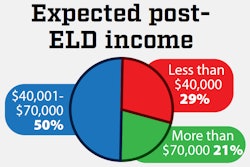A group of researchers this month issued a report on the effects of the electronic logging device mandate, and they reached two main conclusions: The use of ELDs has not reduced the rate of truck crashes, but it has increased the frequency of speeding violations, particularly among the small carrier segment.
Speeding violations, the report concludes, follow behavioral changes driven by ELD adoption as truckers try to make up for productivity losses.
The report mostly focuses on smaller carriers, such as independent owner-operators, whom the researchers deemed most impacted by the mandate. Many larger carriers, it assumes, already had been using ELDs (or predecessor automatic onboard recording devices) prior to the mandate’s December 2017 effective date.
Titled “Did Electronic Logging Device Mandate Reduce Accidents?” and published this month by researchers from Northeastern University and the University of Arkansas, the research report concludes that the mandate was effective in its goal of increased compliance with hours of service regulations. “However,” they write, “there is no evidence to suggest that the number of accidents decreased” as a result.
The researchers studied data on driver inspections and federally recorded crashes between January 1, 2017, and September 1, 2018, with the bulk of the data coming from the Federal Motor Carrier Safety Administration. They studied violations from 4 million inspections of 224,878 for-hire interstate carriers.
Unaccounted for in the study was any control for miles increases or decreases over the time periods, whether in trucks operated or miles driven by the motoring public with whom truckers share the roads. Instead, the research is simply based on weekly averages of violations and crashes. Also unaccounted for is crash fault, such as whether crashes were the fault of truck drivers or other motorists.
The percentage of total hours-of-service violations in sum fell from 6 percent (based on the number of inspections) to 2.9 percent in the mandate’s hard enforcement period, though much of that decrease in violations came from the small carrier segment, the research states. For independent owner-operators, the rate fell from 10.7 percent to 6 percent, while for drivers at larger carriers, the rates fell from 0.85 percent to 0.75 percent.









